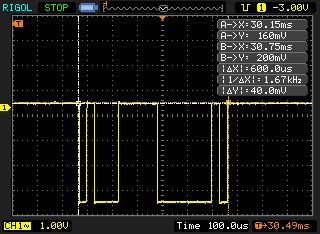MIDI signal in oscilloscope. Inverted serial 31200 bits per second. Captured from USB->MIDI adapter (SWIS). First bit time is about 32us (31.2us = microsecond ). Voltage difference was 3.92V.

A great page describing MIDI: http://www.tigoe.net/pcomp/code/serial-communication/midi which describes MIDI like:
“MIDI is a serial communications protocol, operating at 31,250 bits per second. Each byte has 8 bits, plus a start bit and a stop bit. It operates at 5 volts DC. The standard MIDI connector is a 5-pin DIN connector, and usually all connectors on the device are female, and both ends of a MIDI cable are male.”
From here http://home.roadrunner.com/~jgglatt/tech/midispec.htm :
- MIDI is an asynchronous serial interface.
- The baud rate is 31.25 Kbaud (+/- 1%).
- There is 1 start bit, 8 data bits, and 1 stop bit (ie, 10 bits total), for a period of 320 microseconds per serial byte.
- The MIDI circuit is current loop, 5 mA.
- Logic 0 is current ON.
- To avoid grounding loops and subsequent data errors, the input is opto-isolated. It requires less than 5 mA to turn on. The Sharp PC-900 and HP 6N138 optoisolators are satisfactory devices. Rise and fall time for the optoisolator should be less than 2 microseconds.
- The standard connector used for MIDI is a 5 pin DIN.
- Separate jacks (and cable runs) are used for input and output, clearly marked on a given device (ie, the MIDI IN and OUT are two separate DIN female panel mount jacks).
- 50 feet is the recommended maximum cable length.
- Cables are shielded twisted pair, with the shield connecting pin 2 at both ends.
- The pair is pins 4 and 5. Pins 1 and 3 are not used, and should be left unconnected.